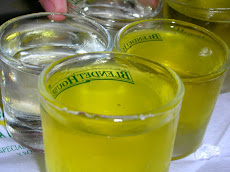Yes, I did let it go for a few more days than initially planned -- 14 versus the 10 prescribed. I'm sure it will only add to the smoothness of the finished product.
So the idea here is to add a simple syrup to dillute the raw brandy to the desired strength. I looked around on the internets to see at what strength commercial orujo de hierbas is typically offered. I saw proofs that ranged from 60 to 70, so I chose to make my finished product 65 proof.
The math is straightforward, and I present it here for your erudition:
- The initial strength of the marc was 44% alcohol by volume, or 88 proof.
- So if I have 375ml of marc there is (0.44*375ml) or 165ml of alcohol to work with.
- I want the finished liqueur to be 65 proof, which is 32.5% alcohol by volume.
- Some algebra is required here:
Solving for W we must add 132.69ml of water per 375ml of marc to arrive at 65 proof
Since I was going to be dosing both batches at once, I measured out 266ml of water and put it in a tiny saucepan. I warmed the water a bit to aid in the dissolving of sugar, but this step was probably not necessary.

 And I added sugar. I cannot tell you exactly how much to be honest. I would have to estimate I probably used roughly 1/4 of a cup of sugar. This was very unscientific of me, but that's the way it goes. The original recipes called for a 1:1 ratio of water in milliliters to sugar in grams. That seemed too sweet to me. So I kept adding sugar to the water until I thought it was a good syrup but not overly sweet.
And I added sugar. I cannot tell you exactly how much to be honest. I would have to estimate I probably used roughly 1/4 of a cup of sugar. This was very unscientific of me, but that's the way it goes. The original recipes called for a 1:1 ratio of water in milliliters to sugar in grams. That seemed too sweet to me. So I kept adding sugar to the water until I thought it was a good syrup but not overly sweet.The next step was to evenly divide the simple syrup into the two batches of hierbas. Look first at what has happened over the last 14 days to Recipe "A":
Noteable diminution of colour and vibrancy...
After adding the syrup, it was time for a second tasting. Below are the two batches, Recipe "A" on the left, and "B" on the right:
First off, the colour of the "B" batch has benefited greatly from the addition of 15 saffron strands some 3 days into the aging process. And then the tasting... "A" has progressed apace, developing a very delicious round herbal flavour. The level of sugar and resulting alcohol level was perfect. I have high expectations for this batch. Batch "B" was surprisingly good. The initial sharpness lent to the infusion from the whole lemon slices was tamed after nearly two weeks aging. While still somewhat acid forward, the other flavours present in "B" are beginning to make themselves known. I am pleased with the progress of both.
Another 10 days or age or so, and it will be time for decanting and filtering. Stay tuned.













